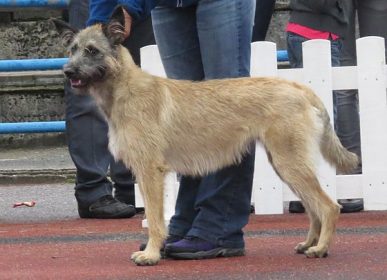
Complete This Name: Bouvier D…………….
You said Bouvier Des Flandres, didn’t you. It’s understandable. It’s the only Bouvier most of us know, but it’s not the only Bouvier. Another herding dog from Belgium is the Bouvier des Ardennes, a breed primarily developed in Liege, Luxemburg and Namur, the Belgian provinces that form part of the Ardennes, and hence, its name, “Ardennes” (all dogs that worked with cattle in that country were once called “Bouvier” – or bovine herder). At present, FCI believes that the Bouvier des Ardennes is facing possible extinction, and we think this would be tragic, particularly after it was thought to be extinct. #SaveOurDogBreeds
The Bouvier des Ardennes is smaller than the Bouvier des Flanders, and it’s ears stand naturally, but in other ways, it is the equal to its hard working cousin. Also known as the Ardennes Cattle Dog, this was a breed that served people living in poverty. Poor folks generally didn’t own horses, so they relied on their dogs to pull carts, turn milk churns, and herd the stock. During World Wars I and II, the breed also served as a poacher’s dog. The wars, and dwindling numbers of farms led to an alarming drop in breed numbers. In fact, it was thought to be extinct.
We love this next part. Researchers collecting colostrum from pregnant cattle in southern Belgium noticed that the dogs owned by local cattle farmers looked remarkably similar to the old Bouvier des Ardennes, which, in fact, they were! Needless to say, the discovery rocked the Belgian canine fancy. Another small group of the dogs, and between 1985 and 1990, breeders and fanciers went into action to save the Ardennes. They relied on a breed standard published in 1923 to use as a yardstick (so to speak), the same year the FCI recognized it. The UKC recognized it as a breed in 2006, but other registries thus far, including the AKC, have not. Hopefully, breed numbers will grow, and this wonderful dog won’t vanish.
Photo of a Bouvier des Ardennes found on Wikiwand

It is interresting to see that several breeds from the region Belgium, Netherlands and North of France have the same familiar look. The Bouvier des Flandres used to be very similar to the Bouviers des Ardennes and much more “wirehaired” than it is today. But also the Dutch wirehaired Shepherd, the Belgian Laekinois and the French Chien de Picardie have always been herding dogs and when you see them together, it is not hard to think there is a family background. It is fascinating to think how similar looking breeds spread over Europe through the ages. 🙂
Isn’t it, Elly? The history of dogs is the history of people, their wanderings, and the influence they had on other people. Romans traveled with ancestors of Rottweilers they used to move the cattle brought along to feed troops on the road. As the number of cattle diminished, the dogs were left behind in outposts or villages, and as you say, its apparent the influence these dogs had on the local canines. Fascinating stuff!
I allways get very exited when i read about, or see a picture of ancient dog breeds. Did you know that Belgium had more pure bred dogs in the 19th and 20th century? I own an old Dutch dog encyclopedia where they name the Epagneul Belge ( Belgian pointing Dog ) who looked a lot like the Epagneul Francais, a breed that is still with us today whereas the Belgian is no more. Another beautifull dog was the Matîn Belge ( Belgian Mastiff ). This breed was especially important during WW I, as it was used to pull carts with ammunition and light artillery and bred only for this particular purpose. Also named in the encyclopedia is the breeds standard. To bad it is written in “old Flemish” and impossible to translate without losing the typical expressions that make it so interesting. I made a drawing of the two breeds as the pictures in my book were impossible to copy. I know there has been an attempt to revive the Mastiff, but as far i know the breed is still hidden in history. The Epagneul is still extinct.
The former drawing was that of the Matîn Belge ofcourse, and here is the Epagneul Belge.
VERY interesting information about our Belgian breeds, Elly (and good gosh, you’re a talented artist!) Though we didn’t set out to do this, we’re slowly amassing a library of old dog books because of the history they “flesh out” of current breeds. Can you imagine how excited those researchers collecting milk had to have been to see these dogs thought to be extinct – and we marvel that they knew what they were seeing when they saw them!